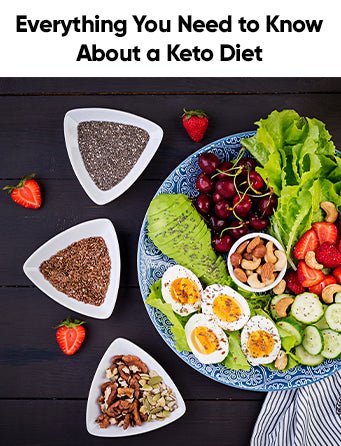
What is a Ketogenic Diet
Share
There are several weight loss regimens out there and also many new diets to choose from. The latest fad diet is the ketogenic diet in which you consume fat rich foods and a minimal amount of carbohydrates. As a result of this diet, the body goes into a metabolic state known as ketosis, causing the blood to become concentrated with ketones. The body uses fats as its main source of energy instead of carbohydrates, which is what leads to weight loss.
How Does Keto Lead to Weight Loss?
In the ketosis state, the body is receiving a restricted amount of glucose due to the absence of carbohydrates which is why fats are broken down for fuel. Normally, it takes about 3 to 4 days to start breaking down the fat in the body for energy instead of carbohydrates. This is when the process of losing weight begins. This state causes a rapid decline in insulin and blood sugar levels. To help your body get into ketosis faster, you may try intermittent fasting in which you limit your food intake to up to 8 hours a day while fasting for the remaining hours.
A ketogenic diet is very similar to an Atkins diet or any other low carb diet. A total of 20-50 grams of carbs per day can be consumed in a keto diet. You can have eggs, meats, fish, nuts, healthy oils and other fats during this time. It is important for you to strike the right balance when consuming proteins as they may be converted into glucose instead of fats. Having too much protein will keep your body from going into ketosis while having too little may result in loss of muscle mass.
The state of ketosis also comes with reduced hunger. There are no fixed meal times. You eat when you are hungry. Some people choose to go with intermittent fasting with this diet, while others choose to skip breakfast and have two meals a day. Some even opt for OMAD along with keto, which is the “One Meal A Day” diet.
Other Benefits of Keto
While the main aim of this diet is to lose weight, it can offer many other health benefits as well. A lifestyle with keto can help you fight and manage many chronic illnesses such as PCOS, type 2 diabetes, metabolic syndrome, heart disease and many more (several other ailments). It also helps minimize inflammation and address insulin resistance.
Foods to Eat and Foods to Avoid
The one downside of keto is that it is very rigid on what you can and cannot eat. One of the hardest things to do on keto is to part with bread and roti. But there is a simple solution for that. There are several flour alternatives such as almond meal flour, flaxseed flour and coconut flour. Not only are they highly nutritious and help with weight loss, they provide several other benefits too. Keto-friendly vegetables include olives, peppers, avocados etc. and all the leafy green veggies. Animal-based proteins are the go-to option on a keto diet.
There are vegetables you must avoid when following such a diet as not all of them are low in carbs. These include large amounts of onions, beets, corn, potatoes or sweet potatoes, or any other starchy vegetable.
The general steps to follow when planning a meal on keto are
- Choosing your protein: It can either be an animal or plant-based protein.
- Select up to two low carb vegetables
- Top it off with your choice of fat to add flavor
Is it Worth Giving Keto Diet a Chance?
Keto’s side effects include fatigue and dizziness in the beginning of the diet which is known as the “keto flu”. These symptoms usually subside within a couple of weeks. Even though a keto diet might not be sustainable in the long run, it can be very beneficial in the short term. It is a quick way to shed a few pounds while also providing other benefits.
